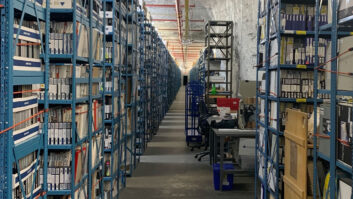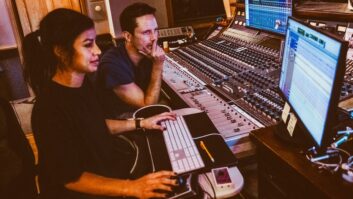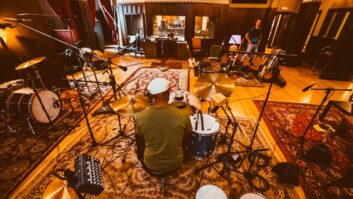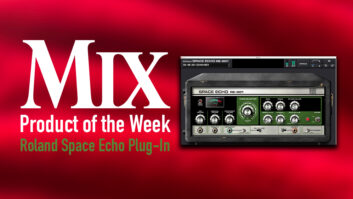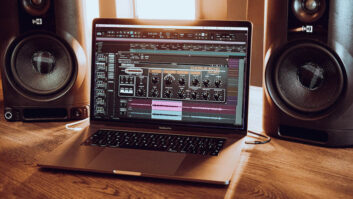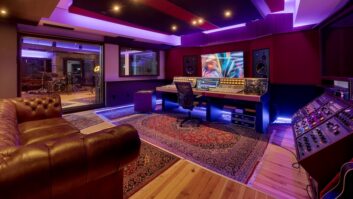By Janice Brown
Asheville, NC (January 29, 2006)–Asheville, NC has been “on the map” among the hippest of mountain towns for years, and it just got even hipper. By happy accident, Steve Wilmans discovered Asheville and a for-sale 1920s Methodist Church, and saw his next venture: move to this cool town and build an awesome destination recording studio. Yes, this is a build-it-and-they-will-come business model, but in Asheville and under Wilmans’ experienced watch, it has a good shot at becoming a creative hub for the area’s almost overgrown music scene.
Wilmans knows all about ripe music scenes. He co-owned a recording studio in the mid ’90s in Seattle, called Stepping Stone, which he sold in 2000 for a healthy profit before moving back to his native southern California. By the time he got to Asheville, on a road trip to help a friend move, he was ready for a new opportunity.
Echo Mountain owner Steve Wilmans (left) in the Neve 8068 control room with designer, George Augspurger.The studio business has changed some since his last go-around, so Wilman has retuned his approach. “I see it as the mid-level studios taking the biggest hit–now it’s either you’re a total home studio, or a big destination facility,” he contends. “I did well enough with the sale of Stepping Stone that I was able to buy this big, beautiful building and not get hit with crazy monthly gear payments and a whole lot of overhead. I can be flexible on rates for local and up-and-coming artists, and I have a four-bedroom house I can offer to out-of-towners.”
Echo Mountain booked its first session with New York City-based rock band, Donna The Buffalo, who came in May to record basic tracks with producer/engineer, Joe Blaney. Actually, Donna The Buffalo’s bass player, Bill Reynolds, is an Asheville native, a friend of Wilmans’ and has been freelance engineering at Echo Mountain ever since. Wilmans says the church structure lent itself beautifully to what Echo Mountain is today, adapted with designs and acoustics by George Augspurger. Live band, choir and small orchestral tracking sessions go down in the church’s main sanctuary, a 40×50-foot room with 20-foot peak ceilings. Augspurger spec’d out the enclosed floating-floor control room and side iso rooms from the existing altar and vestibule, and additional iso booths were formed out of other classroom/vestibules.
The Echo Mountain live room was once the church’s main sanctuary”The layout of the space dictated what we made of it–these side rooms make perfect sense as separate recording rooms,” says Wilmans. “And the main tracking space is perfect for live rock music. It’s a great drum room, and big enough to handle all kinds of instrumental sessions and choirs.” Sightlines and video tie-lines provide versatility, and Augspurger’s custom monitors and stamp of approval after tuning attest to a good balance of controlled acoustics and original sonic character.
Gear-wise, too, Wilmans had little hesitation (see complete list below!). “I’ve always loved the classic Neve sound and really thought that was the way to go–marrying that old analog sound with Pro Tools HD,” he describes. “Especially for the kind of music happening up here in the mountains, people want a more organic, warm analog sound.” The Neve 8068 came to Echo Mountain by way of Steffan Fantini, owner of Classic Studio Equipment in Los Angeles. “We’d been looking for awhile, and he called me one day saying he found it and that I should ‘go to the bank now,'” Wilmans shares, “because there was so much interest. I think I beat out Dave Grohl by hours!”
The board was re-capped by Pat Schneider; John Klett from Tech Mecca handled the install, just weeks before Donna The Buffalo herded in. Wilmans had a healthy equipment collection already, but added substantially to the list. “Stef found me a Telefunken 251 and some other cool mics and guitar amps–I got a Marshall offset prototype, one of only like six in the world–and outboard gear,” Wilmans lists. “I bought a Studer A800 and got 8- and 16-track heads to go with it, and also bought the Pro Tools HD rig.”
While hard-disk recording is a reality, Wilmans is nostalgic for the analog process as he sees it becoming a lost art, especially as prospective interns arrive having only seen a tape machine aligned maybe once before. Producer/engineers and artists, however, will not be at a loss for analog recording and processing at Echo Mountain. As for local, low-budget projects, Wilmans notes, “We keep tape stock around and try to get people to print onto tape and then transfer the tape into Pro Tools, and then we’ll wipe the tape and reuse it. So, they’ll get that analog compression on it.”
The chief engineers (or, at least, the folks working at Echo Mountain the most) are Danny Kadar (My Morning Jacket, Trey Anastasio, Iggy Pop), a Hurricane Katrina refugee who previously spent years as an engineer at Sony Studios in NYC and with Bryce Goggin in his Brooklyn studio; and Reynolds, a sought-after producer in his own right. Kadar and Reynolds have even partnered up under the name Tackle Box, and produced five records at Echo Mountain, after the initial Donna The Buffalo sessions, for regional bands Menage, Screaming Jays, Aaron Price, Fisher Meehan and The Avett Brothers. Kadar has brought Brooklyn-based rock band, Arizona, down to record an album, and Wilmans hopes this band will be the first Echo Mountain Records signing.
With the record-label offshoot of Echo Mountain already plotted and taking shape, Wilmans is in onward and upward mode. “I’ve just bought the building next door, an old dance studio, and am in the process of setting up a B room and an audio post-production room,” he shares. Composer/engineer Bruce Sales is on-staff and responsible for the audio-for-video work coming through Echo Mountain, and will occupy the post suite.
Like the savviest of studio owners, Wilmans knows to make more of this impressive facility. “There are only so many days in a year, and you can only charge so much. We want to have other things going on, become part of the community, and help music we like get exposure.”
VITAL STATS: ECHO MOUNTAIN STUDIOS
Studio Owner: Steve Wilmans
Room Design: George Augspurger
Consoles: 32 channel NEVE 8068 mkII; 2 Chandler EMI Mixers with 24 channel line; 6 channel Mic Pre/EQ, 2 channel Lim/Comp (sidecar); Digidesign Pro Control with extra 16-fader bucket; 12-channel EMI sidecar; 5-channel 1950s Altec tube broadcast console
Multitrack, Tape & Disc Recorders: Studer A800 2″ 24 Track; Pro Tools HD3 with 2 192s and added cards for 24 I/Os; Ampex ATR 102 1/2″ 2 Track; Otari MTR12 1/2″ 2 Track
Monitoring/Amplification: Augspurger Custom Mains; Genelec 1030s; bi-amped NS10’s w/ Bryston amp; Dynaudio Acoustics BM5As; JBL LSR6328Ps; Crown ‘Studio Reference II’ & MacIntosh tube amps on Mains; White Crossovers & EQs
Microphones: Telefunken ELAM 251, (2) KM56, M249; (2) Neumann U67, U87, (2) U47 FET, stereo SM 69, M269, M582, M92, (2) KM84; (2) AKG C12, (2) 414, (4) 451, D112; (2) Sony C37p, (2) C37a; RCA 77-DX; (4) Cole 4038; (2) Royer R121, (2) R122; Beyer M88, M160; (4) Sennheiser 421, (2) E609; Electrovoice RE20; Shure SM beta 57A, (3) SM58, (8) SM57, SM7B; (2) Rode NT2; (2) Josephson E22S, (2) C617 w/MG MK221 omni capsules and (2) MG M94 capsules; (2) Joe Meek JM27
Outboard EQs: (2) Neve 1084, (6) 1081; (2) Chandler Ltd. Germanium; (11) Brent Averill API 312A; (2) Telefunken V72; (2) Trident B Series; (2) Calrec 1161; (2) API 550b EQs; Pultec EQH-2; (2) Demeter tube pre’s; (2) Klein and Hummel all tube EQ; 2 channel Vac Rack 4000 EQ
Compressors/Limiters: (2) EMI TG12413s; (2) Teletronics LA2A; (2) “Black Face” 1176; (2) Neve 33206; (2) Empirical Labs Distressors; (2) DBX 160, (2) 165, (2) 902; (2) ADL C/L1500; (2) Drawmer 1960; (2) Joe Meek Stereo Tube; SSL G-384 stereo compressor; 2-channel Vac Rack 4000 Limiter; Gates STA-Level; RCA 301; (2) Urei LA-3A; (2) WSW Dynamikbegrenzer compressor
Effects and Plug-ins: Lexicon 480L, (2) PCM42 Digital Delay; AMS RMX16; TC Electronics 6000; EMT 140 Plate Reverb; Eventide H3500; SPX 900; Waves Diamond Bundle; Echo Farm; Altiverb; Trillium; Sound Toys Speed; Antares 4 Autotune; Digi Sync i/o; Apogee Big Ben Clock; Black Burst Clock; Master X3 Virtual Finalizer; Culture Vulture Tube Distortion; BBE 822A Sonic Maximizer; Moogerfooger FX Pedals: Lowpass, Phaser, Ring Mod, Analog Delay, MuRF, and Bass MuRF; Boss Ph-3 Phase Shifter; DS-1 Distortion; Pro Co Rat; Ibanez SDR 1000 Stereo digital reverb, Ad-9 Analog Delay; Damage Control Solid Medal Distortion; Vox Duel Overdrive; Electro Harmonix Memory Man; Yamaha SPX1000 Multi-effects processor; Univox Echo Chamber
Instruments and Amps: Yamaha C5 Piano; Hammond B3 Organ w/ 2 Leslies; Fender Rhodes 73; Farfisa organ; Wurltzer 200A; Minimoog Voyager, Moog Therimen; Marshall Prototype Offset JTM45 Head w/ matching offset cab (1962), Marshall 1965 ‘Bluesbreaker’ Combo 2×12 & 4×10, Marshall JTM 45 Head, Marshall ‘Basketweave’ Cab’s straight & slanted w/ greenies; VOX AC30 (1965); Gibson GA79, 1958 Les Paul Jr., LesPaul LPR-8, S.G. (1968), Guild D405b acoustic; Martin D-16GT Acoustic; Fender Strat (pre CBS), P-Bass; Epiphone Thunderbird Bass; Kay C-1 Upright Bass; Supro Royal Reverb Combo amp; Watkins Scout Combo amp, Dominator Combo amp; Hiwatt DR-201; Ampeg Portaflex b-15 Bass Amp
Echo Mountain
www.echomountain.net

